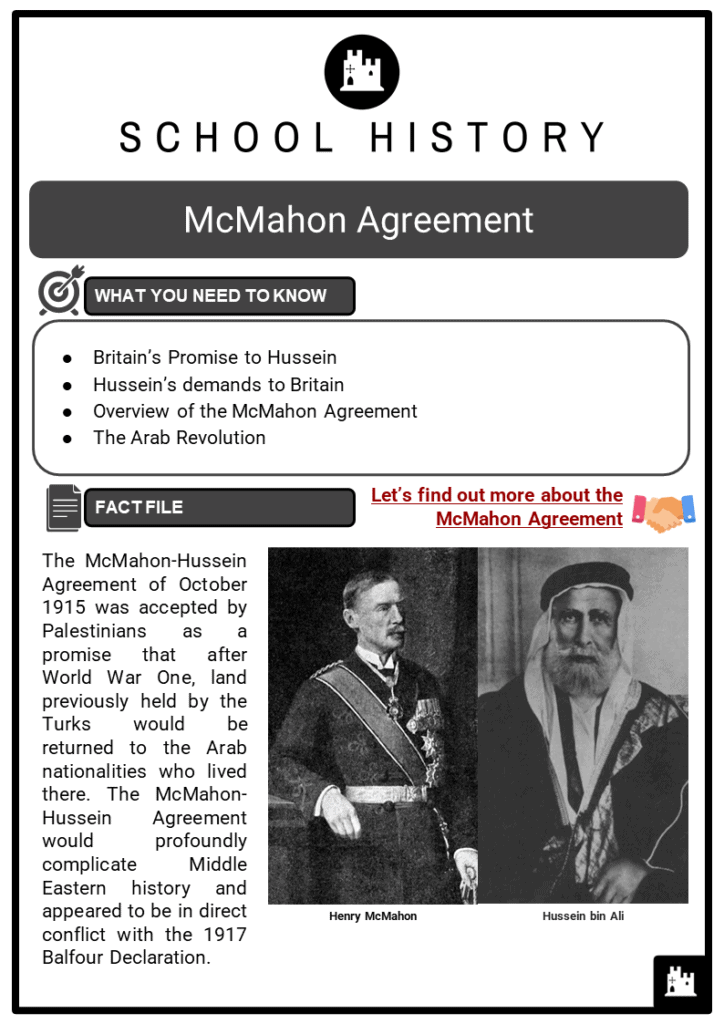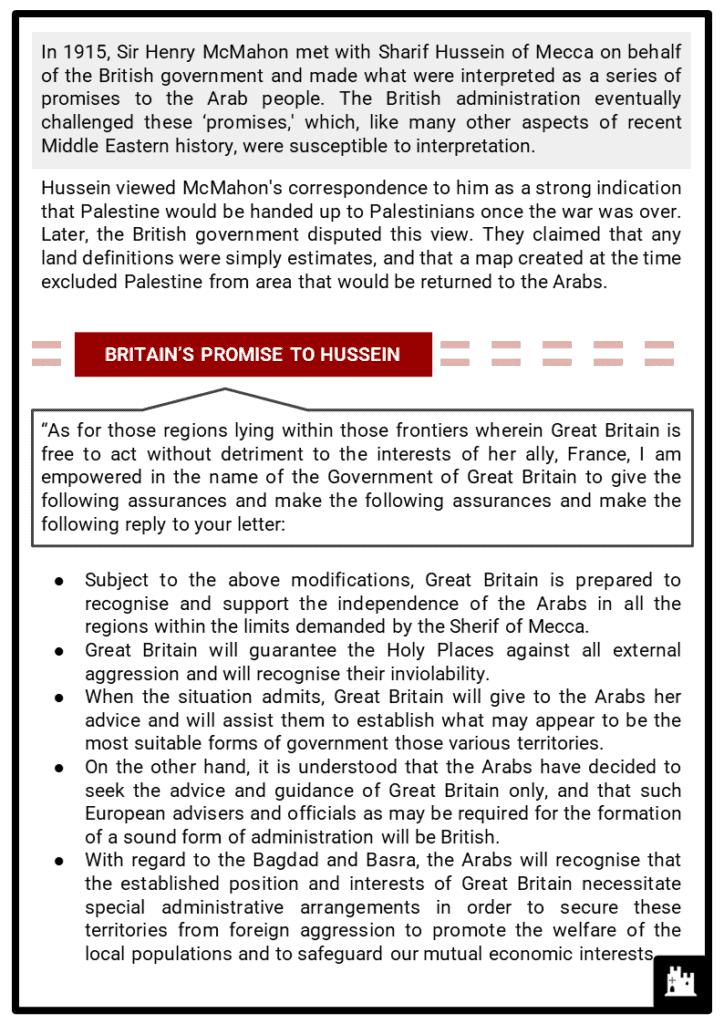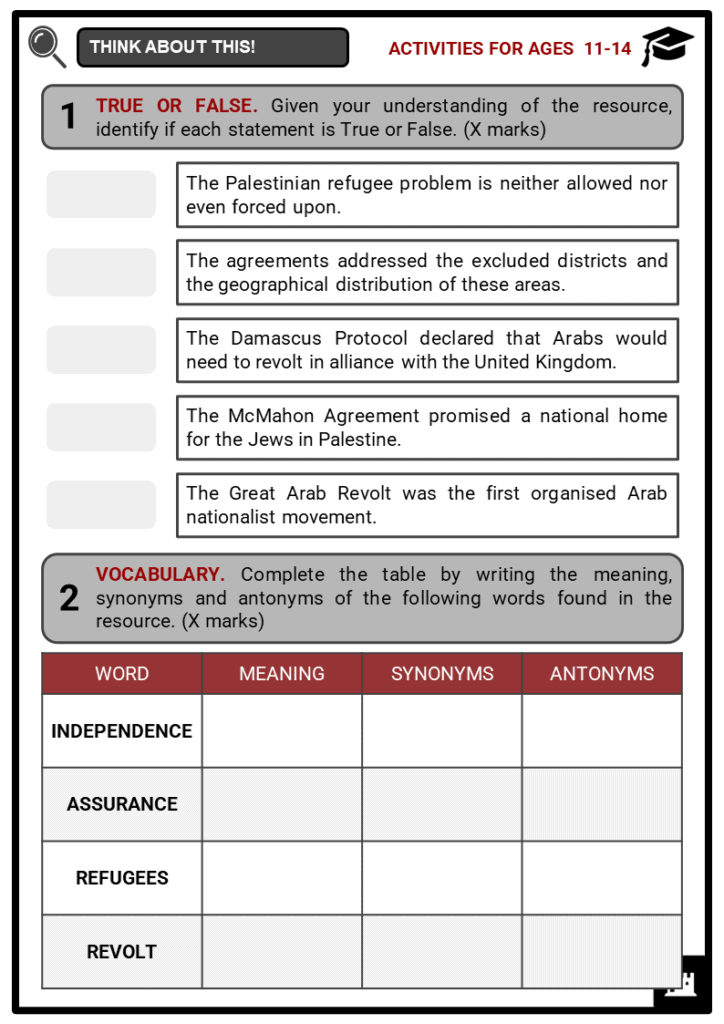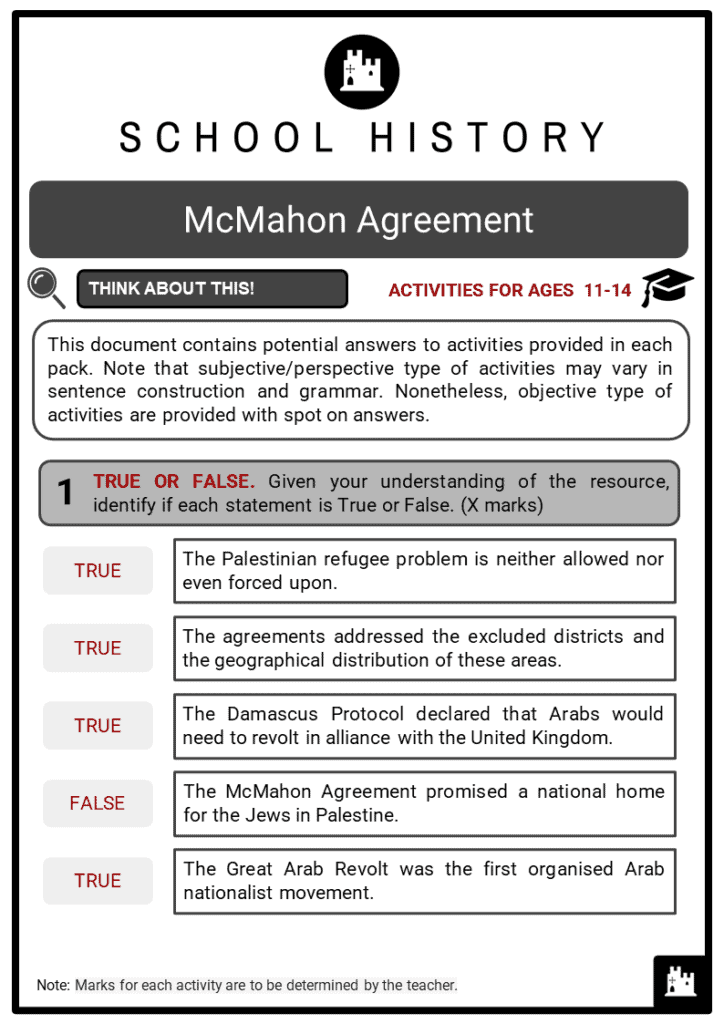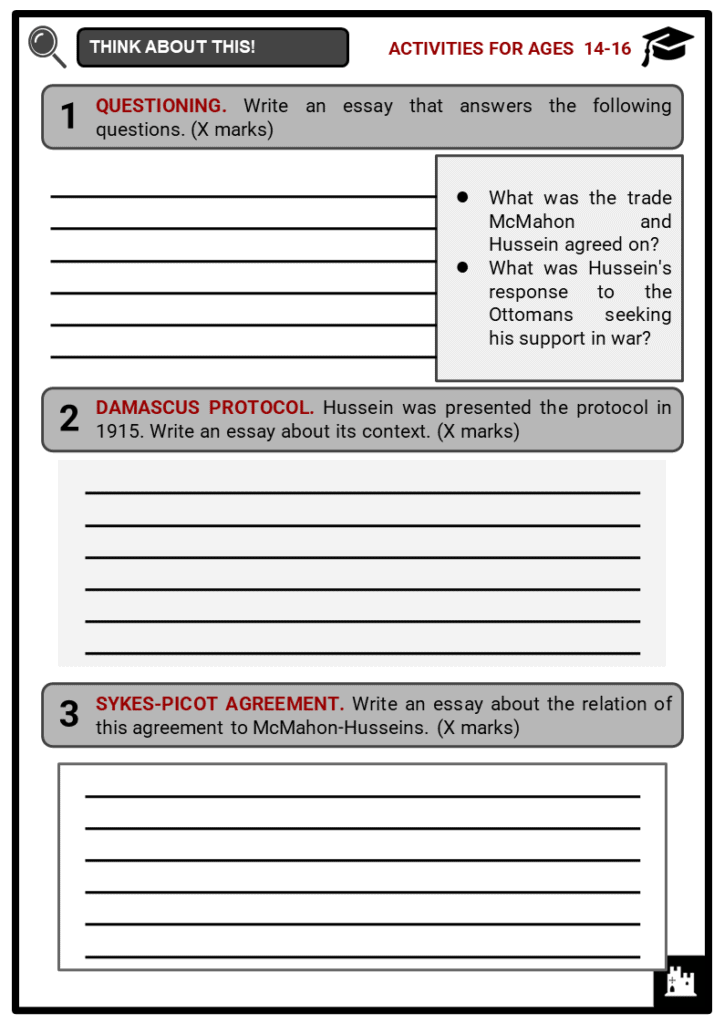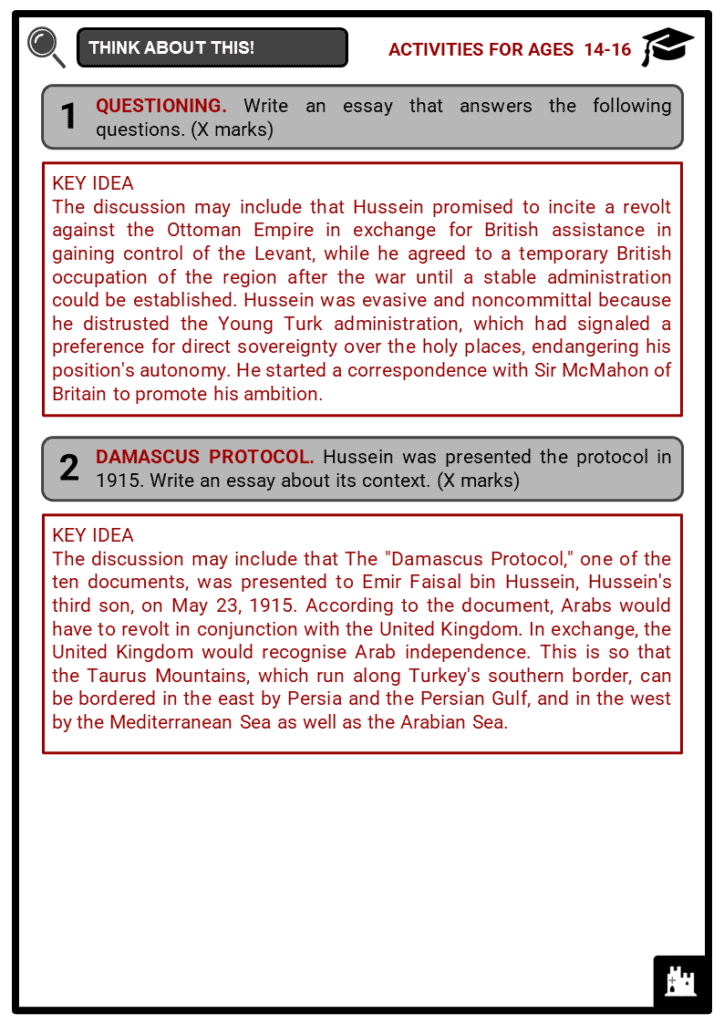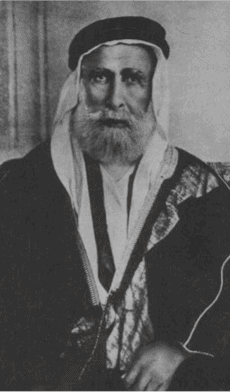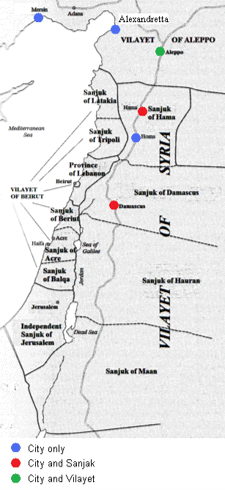Download McMahon Agreement Worksheets
Do you want to save dozens of hours in time? Get your evenings and weekends back? Be able to teach McMahon Agreement to your students?
Our worksheet bundle includes a fact file and printable worksheets and student activities. Perfect for both the classroom and homeschooling!
Table of Contents
Add a header to begin generating the table of contents
Summary
- Britain’s Promise to Hussein
- Hussein’s demands to Britain
- Overview of the McMahon Agreement
- The Arab Revolution
Key Facts And Information
Let’s find out more about the McMahon Agreement
- The McMahon-Hussein Agreement of October 1915 was accepted by Palestinians as a promise that after World War One, land previously held by the Turks would be returned to the Arab nationalities who lived there. The McMahon-Hussein Agreement would profoundly complicate Middle Eastern history and appeared to be in direct conflict with the 1917 Balfour Declaration.
- In 1915, Sir Henry McMahon met with Sharif Hussein of Mecca on behalf of the British government and made what were interpreted as a series of promises to the Arab people. The British administration eventually challenged these ‘promises,' which, like many other aspects of recent Middle Eastern history, were susceptible to interpretation.
- Hussein viewed McMahon's correspondence to him as a strong indication that Palestine would be handed up to Palestinians once the war was over. Later, the British government disputed this view. They claimed that any land definitions were simply estimates, and that a map created at the time excluded Palestine from area that would be returned to the Arabs.
Britain’s Promise To Hussein
- “As for those regions lying within those frontiers wherein Great Britain is free to act without detriment to the interests of her ally, France, I am empowered in the name of the Government of Great Britain to give the following assurances and make the following assurances and make the following reply to your letter:
- Subject to the above modifications, Great Britain is prepared to recognise and support the independence of the Arabs in all the regions within the limits demanded by the Sherif of Mecca.
- Great Britain will guarantee the Holy Places against all external aggression and will recognise their inviolability.
- When the situation admits, Great Britain will give to the Arabs her advice and will assist them to establish what may appear to be the most suitable forms of government those various territories.
- On the other hand, it is understood that the Arabs have decided to seek the advice and guidance of Great Britain only, and that such European advisers and officials as may be required for the formation of a sound form of administration will be British.
- With regard to the Bagdad and Basra, the Arabs will recognise that the established position and interests of Great Britain necessitate special administrative arrangements in order to secure these territories from foreign aggression to promote the welfare of the local populations and to safeguard our mutual economic interests.
- I am convinced that this declaration will assure you beyond all possible doubt of the sympathy of Great Britain towards the aspirations of her friends the Arabs and will result in a firm and lasting alliance, the immediate results of which will be the expulsion of the Turks from the Arab countries and the freeing of the Arab peoples from the Turkish yoke, which for so many years has pressed heavily upon them.” - Henry McMahon
Britain’s Promise To Hussein
- “Firstly.- England will acknowledge the independence of the Arab countries, bounded on the north by Mersina and Adana up to the 37th degree of latitude, on which degree fall Birijik, Urfa, Mardin, Midiat, Jezirat (Ibn ‘Umar), Amadia, up to the border of Persia; on the east by the borders of Persia up to the Gulf of Basra; on the south by the Indian Ocean, with the exception of the position of Aden to remain as it is; on the west by the Red Sea, the Mediterranean Sea up to Mersina. England to approve the proclamation of an Arab Khalifate of Islam.
- - The Arab Government of the Sherif will acknowledge that England shall have the preference in all economic enterprises in the Arab countries whenever conditions of enterprises are otherwise equal.
- - For the security of this Arab independence and the certainty of such preference of economic enterprises, both high contracting parties will offer mutual assistance, to the best ability of their military and naval forces, to face any foreign Power which may attack either party. Peace not to be decided without agreement of both parties.
- - If one of the parties enters into an aggressive conflict, the other party will assume a neutral attitude, and in case of such party wishing the other to join forces, both to meet and discuss the conditions.
- - England will acknowledge the abolition of foreign privileges in the Arab countries, and will assist the Government of the Sherif in an International Convention for confirming such abolition. Sixthly.- Articles 3 and 4 of this treaty will remain in vigor for fifteen years, and, if either wishes it to be renewed, one year’s notice before lapse of treaty is to be given.” - Hussein bin Ali
Overview Of The Agreement
- McMahon’s statements were interpreted by the Arabs as the assurances of Arab independence, which was never accomplished due to the subsequent division of the region into territories controlled by the United Kingdom and France (which had been established in the secret Sykes-Picot agreement of May 1916). A particular controversy arose around Palestine, which official British authorities – and even McMahon – described as exempted from the agreement.
- With the Balfour Declaration in November 1917, Britain claimed to be in favour of the creation of a homestead for Jews.
- As a consequence, the Hussein-McMahon correspondence was discussed again.
- Growing criticism led to an official statement by the then colonial minister Winston Churchill in 1922, the Churchill White Paper, which reaffirmed the Balfour Declaration and McMahon’s view in regards to the Palestinian question.
- Discussions also focused on the international character of the correspondence and the various formulations made therein.
- In particular, it addressed the excluded districts and the geographical distribution of these areas.
- Although the committee was not in a position to conclusively assess the Hussein-McMahon correspondence, as well as other similar correspondences (such as the Hogarth message, a message on behalf of the then British government to Hussein), it came to a very general decision.
- Mainly, Britain had to choose how to shape the future of Palestine, taking into account the interests of the people living there. The first recorded negotiations between the British and Hussein Sharif of Mecca (appointed by the Sultan in 1909) date back to February 1914, five months before the outbreak of the First World War, following the visit of Abdullah Bin Al Hussein, the second son of Hussein bin Ali Sharif to Cairo, and his meeting with Lord Kitchener in Egypt (1911-1914).
- Sharif Hussein was not comfortable with the new Ottoman governor of Hejaz and Heib Pasha, as well as with the growing concern regarding the extension of the Hijaz Railway (opened in 1908 between Damascus and Madinah) to Mecca, which threatened to support the growing Ottoman concentration in the region and to diminish Sharif’s influence.
- The outbreak of the war changed the situation: the Ottoman Empire and Germany signed a secret alliance treaty on 2 August 1914, and on the same day public mobilisation was announced. On November 1, 1914, the Minister of War, sent a letter to Hussein, in which Britain pledged to guarantee the independence, freedom, and rights of the Sharif’s authority against external aggressions, especially the Ottomans, and claimed to support the Hijaz Arabs. Al-Sharif expressed his inability to sever relations with the Ottomans immediately.
- On May 23, 1915 Prince Faisal, the third of the sons of Hussein, presented a document, which was later known as the Damascus Protocol. Faisal received the document when he visited Damascus to complete talks with secret Arab societies such as the Ahed Society. The document pointed out that the Arabs would revolt against their alliance with Britain.
- After consultations in Taif between Hussein and his sons, in June 1915, Faisal (1884-1933) recommended caution: Ali – the eldest son – rebelled against the revolution, while Abdullah II (1882-1951) called for action and encouraged his father to engage in negotiations with Britain. He was responsible for translating, editing and presenting the contents of the letters and for writing reports to McMahon and to the British Foreign Secretary, Ronald Storrs (the Eastern Secretary of the Mission in Cairo), in charge of the relations with the Sharifian authority.
- Between July 14, 1915, and March 10, 1916, ten letters (five on each side) were exchanged between Sir Henry McMahon and Sharif Hussein. Throughout that period, McMahon was in contact with the Secretary of State for Foreign Relations Sir Edward Gray. Gray was representing His Majesty’s Government, and in the end, he became responsible for the correspondence.
The Arab Revolution
- The Arab revolution began in June 1916 when an Arab army which comprised around 70,000 men marched in order to attack the Ottoman forces. This army took part in the seizure of Aqaba and the destruction of the Hijaz railway, a vital strategic link between Damascus and Medina. The dispersal of the Turkish army by the Egyptian Forces under the command of General Edmund Allenby, allowed the invasion of the Ottomans in Palestine and Syria. The British progress in the battle of Megiddo eventually culminated in the surrender of the Ottoman Empire on October 31, 1918.
- Historians believe that the Great Arab Revolt was the first organised Arab nationalist movement. The revolution brought together different Arab groups for the first time under the single objective of fighting for independence from the Ottoman Empire. After the war, Britain established Faisal I as the king of Iraq. The great Arab revolution had a great impact on the hearts and minds of Arab communities.
Image sources:

